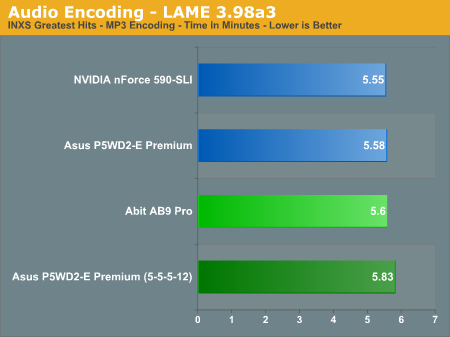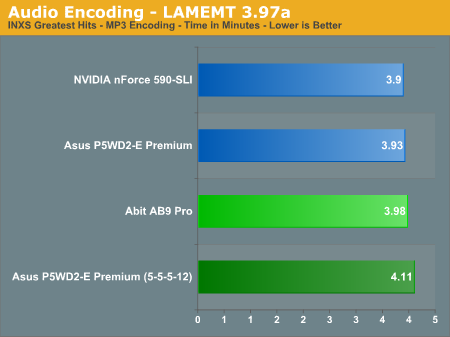Abit AB9 Pro: A sneak peek at Intel's new P965 chipset
by Gary Key on July 3, 2006 3:45 AM EST- Posted in
- Motherboards
Media Encoding Performance
For media encoding, our first test is quite easy - we take our original Office Space DVD and use AnyDVD Ripper to copy the full DVD to the hard drive without compression, thus providing an almost exact duplicate of the DVD. We then fire up Nero Recode 2, select our Office Space copy on the hard drive, and perform a shrink operation to allow the entire movie along with extras to fit on a single 4.5GB DVD disc. We left all options on their defaults except we checked off the advanced analysis option. The scores reported include the full encoding process and is represented in minutes, with lower numbers indicating better performance.

The results left us amazed with the Abit P965 board scoring 7% better than the Asus i975X board at the same memory settings while still bettering our NVIDIA board that placed first in our previous tests. We ran the benchmark several times and verified our settings before accepting the test results. It will be interesting to see if this pattern continues with other P965 based boards.
Audio Encoding Performance
While the media encoding prowess of the Abit AB9 Pro was superb in our initial media encoding testing, we wanted to see how it fared on the audio side. Our audio test suite consists of Exact Audio Copy v095.b4, LAME 3.98a3, LAME MT3.97a-MS Compiler, and Nero Digital Audio. We utilize the INXS Greatest Hits CD that contains 16 tracks totaling 606MB of one time '80s hits.
Our first test consists of utilizing Exact Audio Copy as the front end for our differing versions of LAME. We set up EAC for variable bit rate encoding, burst mode for extraction, use external program for compression, and to start the external compressor upon extraction. (EAC will read the next track while LAME is working on the previous track, thus removing a potential bottleneck with the optical drive.)
Our two versions of LAME consist of the recently released 3.98a3 and LAME MT 3.97a, which is a multi-threaded version of the LAME MP3 encoder. LAME MT was originally designed as a demonstration to show the advantages of multi-threading on the Pentium 4 with Hyper-Threading enabled. Instead of running multiple parallel threads, LAME MT generates the encoder's psycho-acoustic analysis function in a separate thread from the rest of the encoder using a simple linear pipeline. The results are presented in minutes for the encoding process, with lower numbers being better.


As in the media encoding section, the more intensive CPU and storage system tests seem to favor the P965 over the i975X when running at the same memory timings and are near that of the two results at lower memory timings. Even at this early stage we see some benefits of the reworked/enhanced memory controller on the P965. When utilizing LAME MT we see upwards of a 35% improvement in encoding times. This once again shows the advantages of programs written to take advantage of multiple-core processors.
For media encoding, our first test is quite easy - we take our original Office Space DVD and use AnyDVD Ripper to copy the full DVD to the hard drive without compression, thus providing an almost exact duplicate of the DVD. We then fire up Nero Recode 2, select our Office Space copy on the hard drive, and perform a shrink operation to allow the entire movie along with extras to fit on a single 4.5GB DVD disc. We left all options on their defaults except we checked off the advanced analysis option. The scores reported include the full encoding process and is represented in minutes, with lower numbers indicating better performance.

The results left us amazed with the Abit P965 board scoring 7% better than the Asus i975X board at the same memory settings while still bettering our NVIDIA board that placed first in our previous tests. We ran the benchmark several times and verified our settings before accepting the test results. It will be interesting to see if this pattern continues with other P965 based boards.
Audio Encoding Performance
While the media encoding prowess of the Abit AB9 Pro was superb in our initial media encoding testing, we wanted to see how it fared on the audio side. Our audio test suite consists of Exact Audio Copy v095.b4, LAME 3.98a3, LAME MT3.97a-MS Compiler, and Nero Digital Audio. We utilize the INXS Greatest Hits CD that contains 16 tracks totaling 606MB of one time '80s hits.
Our first test consists of utilizing Exact Audio Copy as the front end for our differing versions of LAME. We set up EAC for variable bit rate encoding, burst mode for extraction, use external program for compression, and to start the external compressor upon extraction. (EAC will read the next track while LAME is working on the previous track, thus removing a potential bottleneck with the optical drive.)
Our two versions of LAME consist of the recently released 3.98a3 and LAME MT 3.97a, which is a multi-threaded version of the LAME MP3 encoder. LAME MT was originally designed as a demonstration to show the advantages of multi-threading on the Pentium 4 with Hyper-Threading enabled. Instead of running multiple parallel threads, LAME MT generates the encoder's psycho-acoustic analysis function in a separate thread from the rest of the encoder using a simple linear pipeline. The results are presented in minutes for the encoding process, with lower numbers being better.


As in the media encoding section, the more intensive CPU and storage system tests seem to favor the P965 over the i975X when running at the same memory timings and are near that of the two results at lower memory timings. Even at this early stage we see some benefits of the reworked/enhanced memory controller on the P965. When utilizing LAME MT we see upwards of a 35% improvement in encoding times. This once again shows the advantages of programs written to take advantage of multiple-core processors.










33 Comments
View All Comments
JarredWalton - Monday, July 3, 2006 - link
Corrected - the retail HSF was used, but it doesn't really matter since we didn't perform thorough overclocking, noise, or temperature testing yet. As mentioned in the article, we're waiting for a new BIOS release with memory timing adjustments before we do that.Heidfirst - Monday, July 3, 2006 - link
"This heatsink is part of the Abit Silent OTES technology that includes a heatpipe system and additional passive cooling for the VRM components. This system kept the MCH cool enough that additional chipset voltage was not a factor in our overclocking tests. Our only concern is the lifespan of the fanbut it is very quiet during operation"What fan?
JarredWalton - Monday, July 3, 2006 - link
Sorry - that was a fragment from an earlier article that slipped in. No fans. :)ALCX - Monday, July 3, 2006 - link
You didn't mention anything about how well this board overclocks! I would think with this 'stable' power and the D805 you would have an excellent opportunity. I'm also thinking getting a mboard like this with a $100 D805 and wait out Conroe supply issue/price until XMAS....ALCX
jones377 - Monday, July 3, 2006 - link
Do you have any plans to investigate I/O performance on this chipset? Those Winrar benches suggests these were vastly improved somehow. Memory latency/bandwidth benchmarks would be nice too. All compared to 975x, nvidia and ATI chipsets (for the Intel platform).mine - Saturday, July 8, 2006 - link
yes rightthis is what I am exspecting from anand in near future
if you like the info a little bit earlier
over@ xs
Chadder007 - Monday, July 3, 2006 - link
Im thinking about getting a motherboard like this and a Pentium D 805....and then waiting for the prices to go down and performance to go up for the Core 2's after maybe 1 year to upgrade.rqle - Monday, July 3, 2006 - link
I prefer a next gen board without the floopy, am still waiting. Keep PATA, well, third party chipset now, but kill off the floopy.Calin - Tuesday, July 4, 2006 - link
I'm all for it too - as long as you can install Windows on any computer without needing a floppy disk driveMacGuffin - Monday, July 3, 2006 - link
Or atleast X4 physical connectors, if X16 slots make things cramped for capacitors and other parts on the board. And what's up with this trend of 5/6 expansion slots on high-end motherboards? There was a time when most boards had 7 expansion slots. I guess the elaborate heatpipe mechanisms for 2-chip core logic interfere (eg. M2N-SLI vs. M2N32-SLI) with more expandability.
This is going to be a good year for technology!